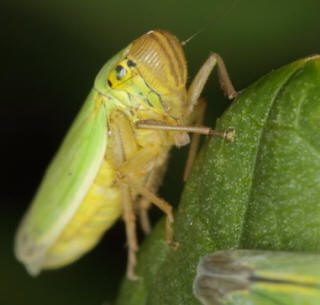Unsightly but not really a problem is the best
way to sum up Cuckoo spit, or
Froghopper if we are talking of the adult form. (Scientifically is goes
under the name of Philaenus spumarius.)
The small adult insects that are subject to the name Froghopper,
because of their jumping prowess – especially when threatened – lays its
eggs on plant stems in May –June. Grassy plants on thee edges of
woodland are a favourite habitat, but it also enjoys areas of the garden
where perennials and grasses with long stems are growing.
The emerging larva then cover themselves in a frothy coating giving it the other name of Cuckoo Spit. The ‘Cuckoo’ part probably as a result of it appearing at the same time as the sound of the first cuckoos! (That’s the theory anyway!) In reality it is a concoction of plant sap and natural ‘excretion’ from the cuckoo spit larva.
 I could probably make a better case for leaving this insect in peace
– rather than trying to eradicate it, for it does so little in the way
of real damage – other than is appearance!
I could probably make a better case for leaving this insect in peace
– rather than trying to eradicate it, for it does so little in the way
of real damage – other than is appearance!
The cuckoo spit 'nest' together with the disturbed Froghopper.
Sucks a bit of sap, but not a real problem. As with all insects, it has its own group of natural predators, which it tries to deter with the globule of spittle-like under which the young live and feed off the plant stem to which it is attached. It is a sap sucker, but one that appears when there is plenty of sap to be had by the plant, and is rarely in sufficient numbers to worry the plant – or gardener.
Its main ‘threat’ to the gardener, is its appearance as spit!
 The
ability of the adult to jump – hence the name Froghopper – has been the
subject of a scientific study, which found a genetic substance, that is
instrumental of its world beating (for body weight) leaps. This is now
being isolated and attempts are underway to include this natural
phenomenon in the manufacture of athletic footwear. (Look out for some
record breaking stats from the high jumps in future!)
The
ability of the adult to jump – hence the name Froghopper – has been the
subject of a scientific study, which found a genetic substance, that is
instrumental of its world beating (for body weight) leaps. This is now
being isolated and attempts are underway to include this natural
phenomenon in the manufacture of athletic footwear. (Look out for some
record breaking stats from the high jumps in future!)
Hidden beneath the cocoon of 'spit' is a little young Froghopper - sucking away at the sap. Even if they are seen in large numbers, they rarely do enough damage to get worried about. Because of their protective cuckoo spit coating, they are difficult to treat with insecticides, and not really worth the bother. Simply wash them off with a jet of water, or better still, leave them to natural predation to sort out. It is normally 'visual through June until September, when they disappear from sight leaving no discernable damage behind them.
Main Page for Apple Tree Problems